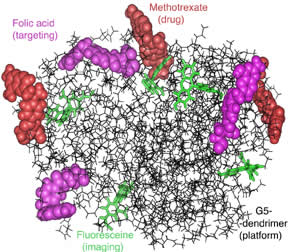Home > Press > Nanoparticles transport cancer-killing drug into tumor cells
Abstract:
U-M scientists use folic acid as bait to get methotrexate inside tumor cells
Nanoparticles transport cancer-killing drug into tumor cells to increase efficacy, lower drug toxicity in mice
Ann Arbor, MI | June 15, 2005
University of Michigan scientists have created the
nanotechnology equivalent of a Trojan horse to smuggle a powerful
chemotherapeutic drug inside tumor cells - increasing the drug's
cancer-killing activity and reducing its toxic side effects.
Previous studies in cell cultures have suggested that attaching
anticancer drugs to nanoparticles for targeted delivery to tumor cells
could increase the therapeutic response. Now, U-M scientists have shown
that this nanotechnology-based treatment is effective in living
animals.
"This is the first study to demonstrate a nanoparticle-targeted drug
actually leaving the bloodstream, being concentrated in cancer cells,
and having a biological effect on the animal's tumor," says James R.
Baker Jr., M.D., the Ruth Dow Doan Professor of Biologic Nanotechnology
at the University of Michigan, who directed the study.
"We're very optimistic that nanotechnology can markedly improve
cancer therapy," says Baker, who directs the Michigan Nanotechnology
Institute for Medicine and the Biological Sciences. "Targeting drugs
directly to cancer cells reduces the amount that gets to normal cells,
increases the drug's anti-cancer effect and reduces its toxicity. By
improving the therapeutic index of cancer drugs, we hope to turn cancer
into a chronic, manageable disease."
Results of the study will be published in the June 15, 2005, issue of
Cancer Research.
The drug delivery vehicle used by U-M scientists is a manmade polymer
molecule called a dendrimer. Less than five nanometers in diameter,
these dendrimers are small enough to slip through tiny openings in cell
membranes. One nanometer equals one-billionth of a meter, which means it
would take 100,000 nanometers lined up side-by-side to equal the
diameter of a human hair.

James R. Baker Jr., M.D.
|
Dendrimers have a tree-like structure with many branches where
scientists can attach a variety of molecules, including drugs. In
experiments reported in Cancer Research, U-M scientists attached
methotrexate, a powerful anticancer drug, to branches of the dendrimer.
On other branches, they attached fluorescent imaging agents and their
secret ingredient - a vitamin called folic acid.
Folic acid, or folate, is an important vitamin required for the healthy
functioning of all cells. But cancer cells, in particular, seem to need
more than average amounts. To soak
up as much folate as possible, some cancer cells display more docking
sites called folate receptors on their cell membranes. By taking
advantage of a cancer cell's appetite for folate, U-M scientists are
able to prevent the cells from developing resistance to chemotherapeutic
drugs.
"It's like a Trojan horse," Baker explains. "Folate molecules
on the nanoparticle bind to receptors on tumor cell membranes and the
cell immediately internalizes it, because it thinks it's getting the
vitamin it needs. But while it's bringing folate across the cell
membrane, the cell also draws in the methotrexate that will poison
it."
In conventional chemotherapy, drugs like methotrexate must diffuse
across a cell membrane to get inside cancer cells, according to Baker.
It's a slow process and requires a high concentration of drug in the
extra-cellular fluid, which can damage normal cells and tissues.
When tested in laboratory mice that had received injections of human
epithelial cancer cells, the nanoparticle-based therapy using folic acid
and methotrexate was 10 times more effective at delaying tumor growth
than the drug given alone. Nanoparticle treatment also proved to be far
less toxic to mice in the study than the anticancer drug alone.
"In our longest trial, which lasted 99 days, 30 percent to 40 percent
of the mice given the nanoparticle with methotrexate survived," says
Jolanta Kukowska-Latallo, Ph.D., a U-M research investigator and first
author of the study. "All the mice receiving free methotrexate died -
either from overgrowth of the tumor or from toxic effects of the drug.
"We saw statistically significant tumor growth reduction in all the
mice given targeted nanoparticle therapy, as opposed to mice receiving
either free methotrexate or the dendrimer alone," adds
Kukowska-Latallo. "Effectively, we achieved a 30-day tumor growth
delay. Taking into account the length of a mouse's life, that is
significant. One month for a mouse is about three years for a
person."
Before they began to study the effects of targeted nanoparticle therapy
on cancer, U-M scientists injected dendrimers with fluorescent tags into
the bloodstream of laboratory mice to determine where they would be
retained in the body. The results showed that the kidneys quickly
filtered free nanoparticles from blood and eliminated them in urine. The
researchers found no evidence that nanoparticles were able to leave the
bloodstream and enter the brain. The nanoparticles did not appear to
generate an immune response in mice in the study.
In future research, scientists at the Michigan Nanotechnology Institute
will determine the maximum therapeutic dose, in research animals, of
targeted nanotherapy with methotrexate, and complete other preliminary
studies in preparation for the first human clinical trial, which Baker
says is scheduled to begin within two years.
Researchers at the Michigan Nanotechnology Institute also are planning
to explore the use of nanotechnology-based therapies using other
chemotherapeutic drugs. "There are many cancer drugs that are very
effective, but they can't be used now, because they are too toxic,"
Baker says. "If these drugs can be delivered with a targeted
nanoparticle system, we may be able to overcome the toxicity problem and
provide a broader range of therapeutic agents for people with
cancer."
By attaching different targeting molecules and different drugs to the
nanoparticle, Baker believes scientists eventually will be able to
develop effective therapies for many types of cancer, perhaps even
personalized therapy for an individual's specific cancer.
The research was funded by the National Cancer Institute. The
University of Michigan has filed a patent application on targeted
nanoparticle technology. A licensing agreement is currently being
negotiated with Avidimer Therapeutics, a biopharmaceutical company in
Ann Arbor, Mich. Baker holds a significant financial interest in the
company.
Other U-M collaborators in the research study are Zhengyi Cao, M.D.,
and Shraddha S. Nigavekar, Ph.D., U-M research associates; Istvan J.
Majoros, Ph.D., research investigator; and Thommey P. Thomas, Ph.D.,
assistant research professor. Additional collaborators who were formerly
with the U-M are Lajos P. Balogh, Ph.D., Kimberly A. Candido, and
Mohamed K. Khan, M.D
Contact:
Sally Pobojewski
Senior Science Writer
Office of Public Relations/Marketing Communications
University of Michigan Medical School
Phone: (734) 615-6912
FAX: (734) 615-2169
pobo@umich.edu
Nicole Fawcett
nfawcett@umich.edu
(734) 764-2220
Copyright © University of Michigan
If you have a comment, please Contact us.
Issuers of news releases, not 7th Wave, Inc. or Nanotechnology Now, are solely responsible for the accuracy of the content.
| Related News Press |
Possible Futures
![]() Spinel-type sulfide semiconductors to operate the next-generation LEDs and solar cells For solar-cell absorbers and green-LED source October 3rd, 2025
Spinel-type sulfide semiconductors to operate the next-generation LEDs and solar cells For solar-cell absorbers and green-LED source October 3rd, 2025
Nanomedicine
![]() New molecular technology targets tumors and simultaneously silences two ‘undruggable’ cancer genes August 8th, 2025
New molecular technology targets tumors and simultaneously silences two ‘undruggable’ cancer genes August 8th, 2025
![]() New imaging approach transforms study of bacterial biofilms August 8th, 2025
New imaging approach transforms study of bacterial biofilms August 8th, 2025
![]() Cambridge chemists discover simple way to build bigger molecules – one carbon at a time June 6th, 2025
Cambridge chemists discover simple way to build bigger molecules – one carbon at a time June 6th, 2025
![]() Electrifying results shed light on graphene foam as a potential material for lab grown cartilage June 6th, 2025
Electrifying results shed light on graphene foam as a potential material for lab grown cartilage June 6th, 2025
Announcements
![]() Rice membrane extracts lithium from brines with greater speed, less waste October 3rd, 2025
Rice membrane extracts lithium from brines with greater speed, less waste October 3rd, 2025
![]() Researchers develop molecular qubits that communicate at telecom frequencies October 3rd, 2025
Researchers develop molecular qubits that communicate at telecom frequencies October 3rd, 2025
![]() Next-generation quantum communication October 3rd, 2025
Next-generation quantum communication October 3rd, 2025
![]() "Nanoreactor" cage uses visible light for catalytic and ultra-selective cross-cycloadditions October 3rd, 2025
"Nanoreactor" cage uses visible light for catalytic and ultra-selective cross-cycloadditions October 3rd, 2025
|
|
||
|
|
||
| The latest news from around the world, FREE | ||
|
|
||
|
|
||
| Premium Products | ||
|
|
||
|
Only the news you want to read!
Learn More |
||
|
|
||
|
Full-service, expert consulting
Learn More |
||
|
|
||









